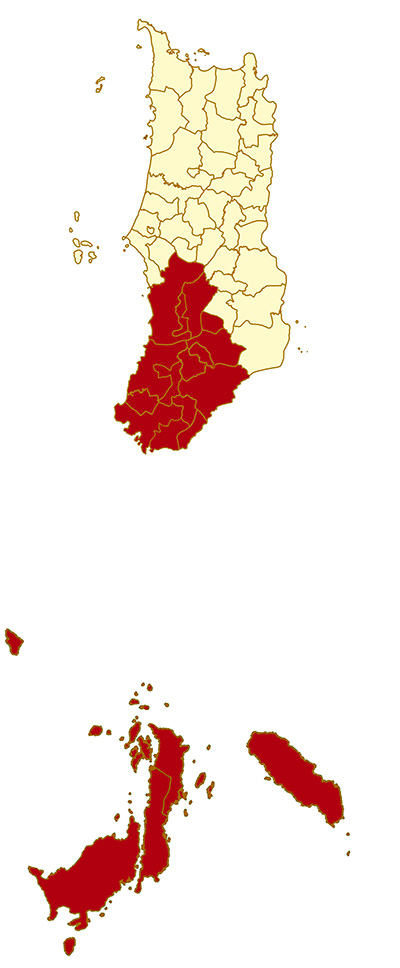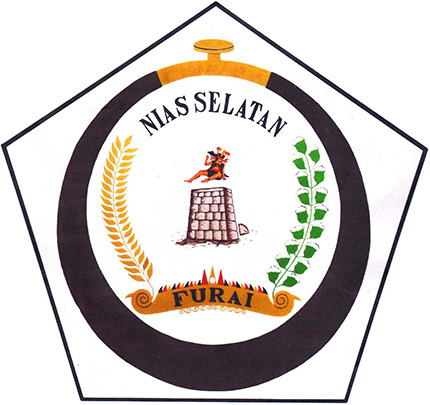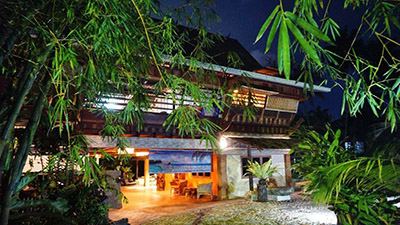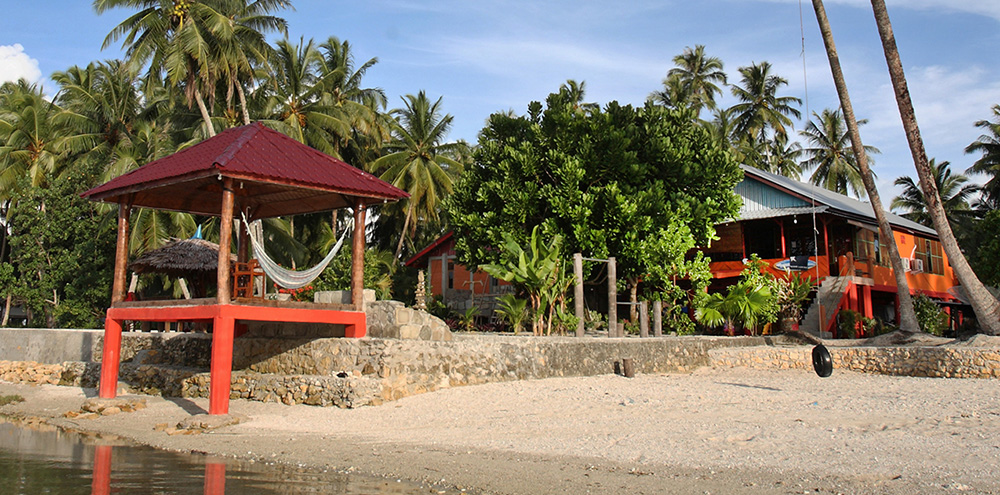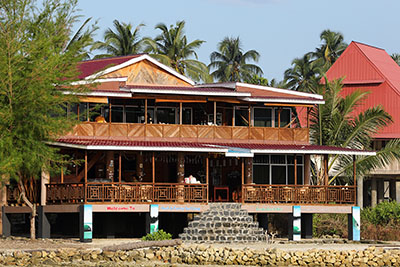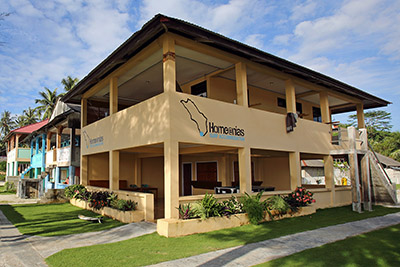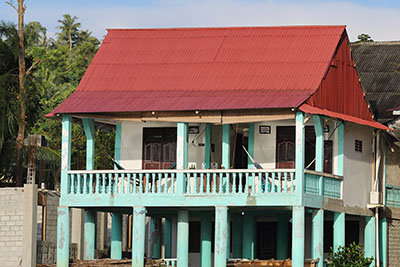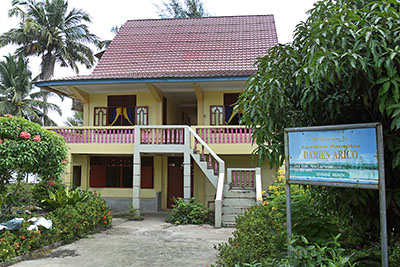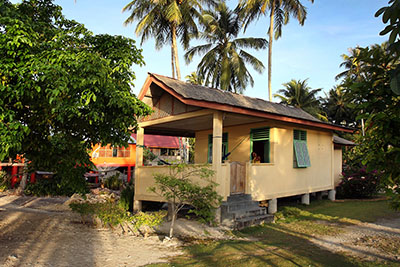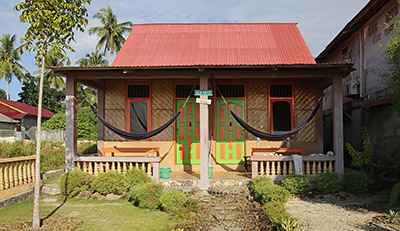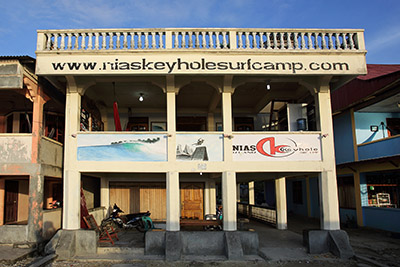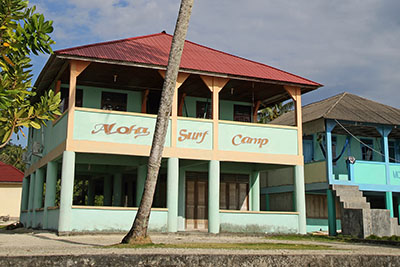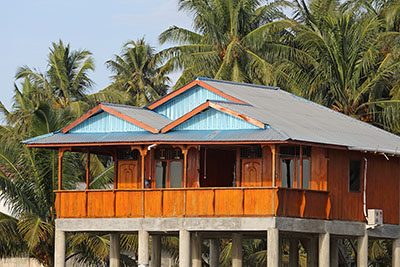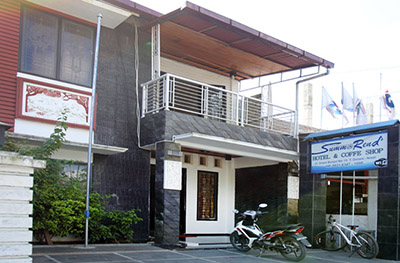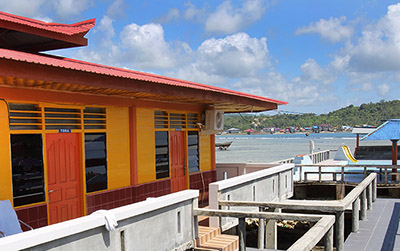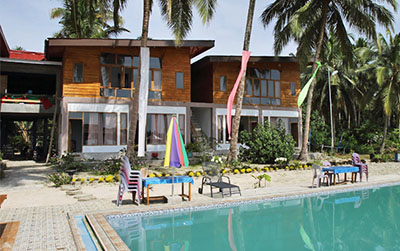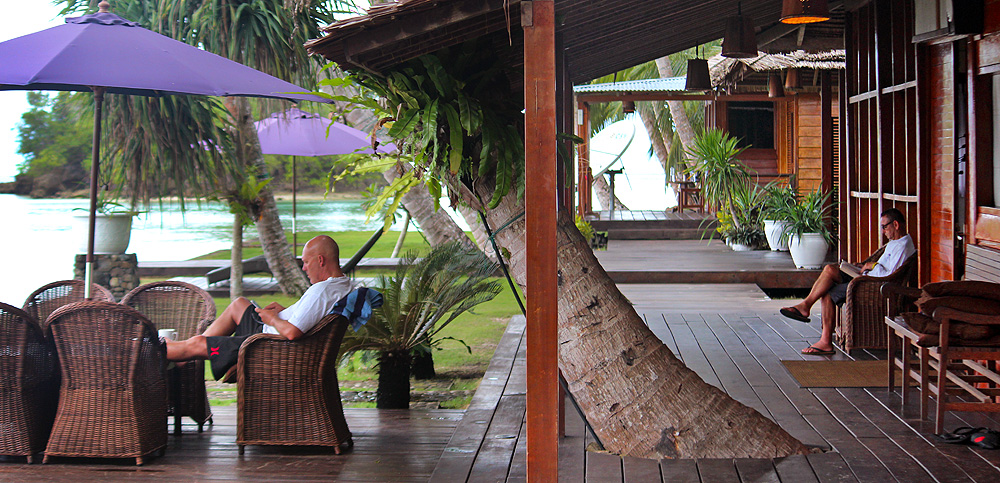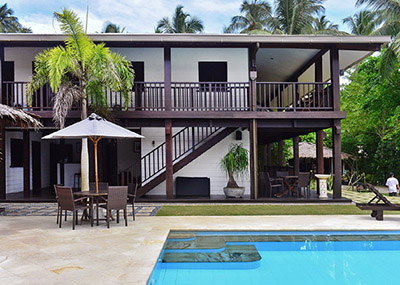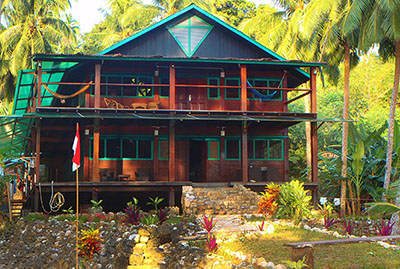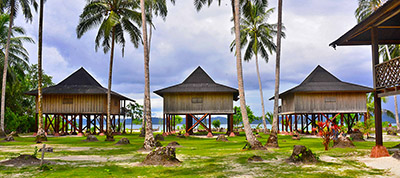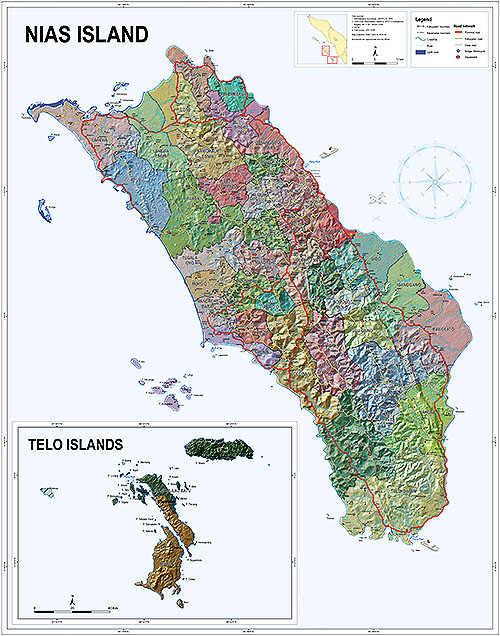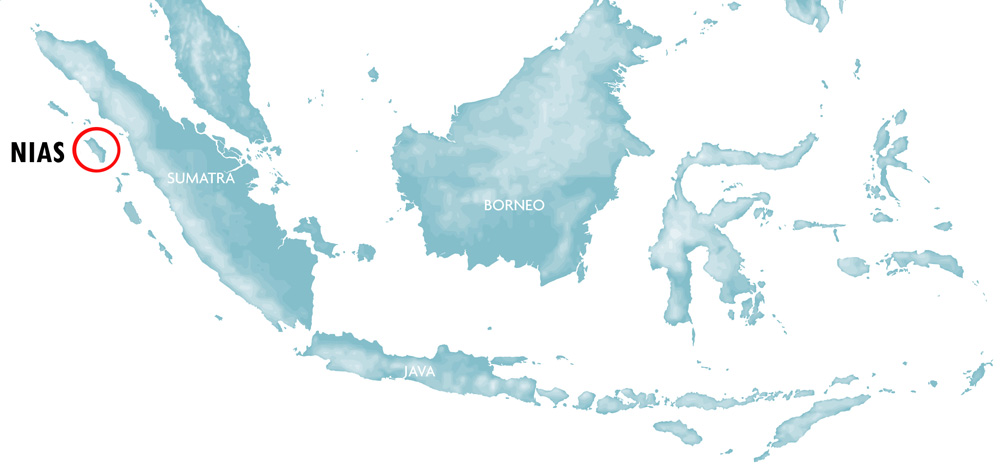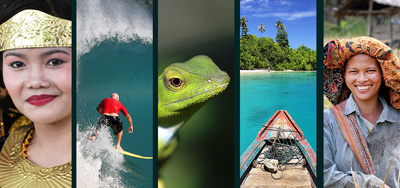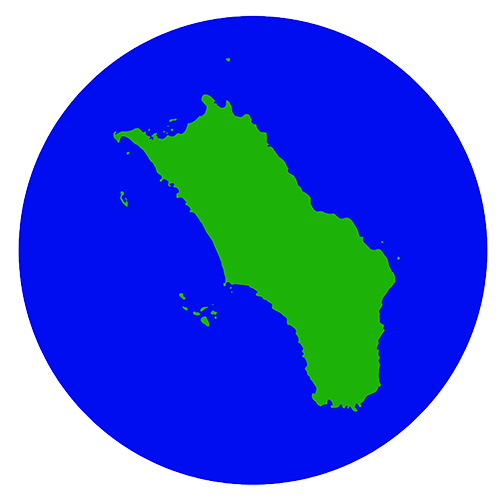South Nias Regency
South Nias Regency covers the bottom part of Nias Island and it is the largest district on Nias Island. South Nias also includes the Telos (Batu Islands), a group of Island between Nias and Mentawai. Without a doubt the south is the most popular area of Nias and in the past the overwhelming majority of visitors were surfers heading to Sorake and the waves in Lagundri Bay. Apart from world-class surf waves the south has also been blessed with some of Indonesia’s most spectacular cultural heritage sites with a number of traditional villages and megaliths within easy reach for visitors. Like the rest of Nias the coastline and countryside of the south has many hidden gems for those who care to look. Despite being the most popular area, tourism in the south is mainly concentrated around Sorake Beach in Lagundri Bay. A short drive up the coast reveals undeveloped beaches, rice fields and a lush tropical landscape. There is still much to explore in South Nias!
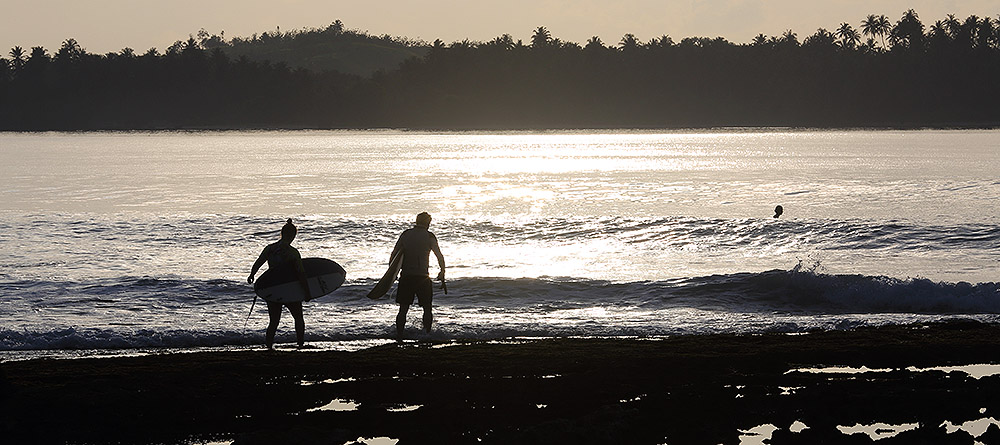
Early morning surf at “The Point” in front of Sorake in Lagundri Bay.
Tourists started coming to Nias after the wave in Lagundri Bay was discovered by three Australian surfers in 1975. Soon Lagundri was a ‘must-see’ place for Indonesia bound surfers and also for many travellers along the ‘banana-pancake trail’ across Southeast Asia. By the mid-eighties there was a thriving surf and backpacker scene here with many guesthouses along the bay. Due to the difficulty in getting to South Nias it never developed into a mass tourism destination. 2004 -2005 was a big setback for the Lagundri area as many guesthouses were destroyed during the Boxing Day Tsunami and the subsequent earthquake a few months later. Today most of Sorake has been rebuilt and the roads to the south are better than they ever been. As Nias is slowly being discovered by travellers other than surfers, many of them come to Sorake to use it as a base for exploring the culture and natural sights of South Nias.
Telo Islands was ‘discovered’ and explored by adventurous surfers from Nias. For a long time the only way to stay there was on-board surf charter boats. In the last decade Telos have developed separately from the rest of Nias, as a number of high end surf resorts have been established on the islands. Here you can find some of the best (and most expensive) resorts in this part of Indonesia. The people who go to Telos often bypass Nias Island completely and pay top dollar for good service, comfort and uncrowded waves. Today a few budget options are available as well and non-surfing travellers have started making their way to this remote corner of Indonesia.
Accommodation in South Nias
There are many places to stay in Sorake and nearby Teluk Dalam. It’s always good to book ahead, but even if you don’t there will always be rooms available. Telo Islands is a different matter with resorts often booked out months ahead. Read more about South Nias accommodation in the ‘where to stay’ section off this page.

The south end of Sorake beach, in front of the ‘indicators’. There are some 40 guesthouses in Lagundri Bay.
Surfing
Surfing remains the major draw card for people coming to South Nias. The wave known as The Point, Sorake or Lagundri is usually included in the top-ten lists of the best waves worldwide. The wave is very consistent and easily accessed. A row of guesthouses have been built along the shore and most of them have great view of the wave and are only a few minutes from the entry point. Sorake is very much focused on surfing; if you are a surfer it doesn’t get much better than this! Apart from the main wave there are a number of different waves in the area of varying levels and styles. Learn more about the surfing in South Nias here.
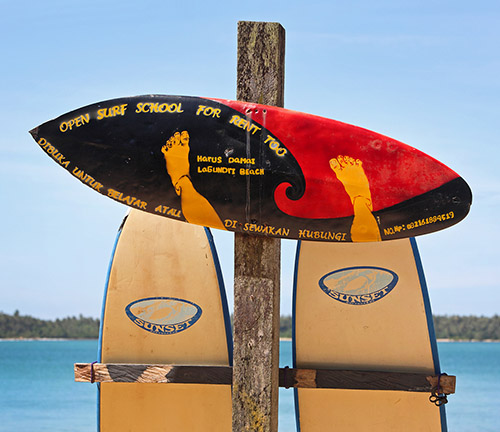
Surf school for beginners on Lagundri Beach.
South Nias is not only for hard-core surfers. This is actually a very good place to learn surfing. Lagundri Beach inside the bay has a surf school staffed by experienced local surfers willing and able to help beginners out. If you progress beyond the beach break stage there are excellent places for beginners nearby, such as Kiddies corner just inside the Point in Sorake. Many beginners’ surfers also come to Sorake in the low-season when the waves are smaller than during the April to October swell season.
Beaches
There are some great beaches around the south, but perhaps less than in other parts of Nias. This is an overview of accessible beaches in the South. The name for beach in Indonesian is Pantai.
Lagundri Beach
This is the most famous beach on Nias, located deep inside Lagundri Bay. The beach is about 20 minutes’ walk from Sorake and in the past most non-surfers preferred to stay here because it a much more beautiful location. This beach had it all, nice white sand, turquoise water and swaying palm trees under which backpackers were chilling out in hammocks. The Boxing Day Tsunami washed away most the beach bungalows and the 2005 Earthquake knocked over what was still standing. For years after the beach was a mess, and to make ends meet some of the owners started mining sand to be sold for construction. Today the beach has been cleaned up, but it has not yet recovered to its former glory. One hotel and a surf school have opened again and the west end of the beach is still very nice. Lagundri is the best and safest place for swimming in the South. Most of the week the beach is all but deserted but on Sundays hundreds of locals gather here and it can get very busy. Unfortunately the Sunday crowds generate a fair amount of litter.
Sorake Beach
The name is a bit misleading because Sorake is not a beach as such. This is where the guesthouses are concentrated and the best surfing can be found. It’s a great place, but if you want to relax on a sandy beach or go for a swim you are better off at nearby Lagundri Beach or around the corner at Sobatu.
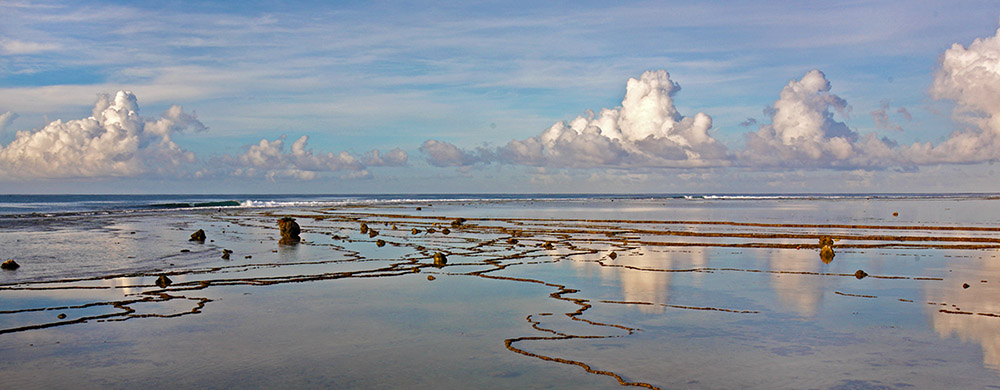
The view from the guesthouses in Sorake. After the 2005 earthquake the reef was uplifted and exposed.
Sobatu and Sema-Sema
Sobatu is a nice section of the coast 20 minutes’ walk from Sorake. Simply walk along the beach westward (past Barriga Feliz Surf Camp) for about 2 kilometers. Most of the coast is uplifted reef and it’s hard to enter the water. But eventually you reach an area with a narrow beach lined by coconut trees. In this area there are several channels in the reef, similar to the keyhole in Sorake, where you can enter the water. From here it is another four kilometers along the coast to a beach called Sema-Sema. This is a great afternoon (or morning) walk out of Sorake. Amazing sunsets are often seen here! If you have a motorbike you can skip the walk by driving up the hill past Botohili village, continue on a small road to the headland north of Sorake. Park and walk downhill along a track to Sema-Sema.
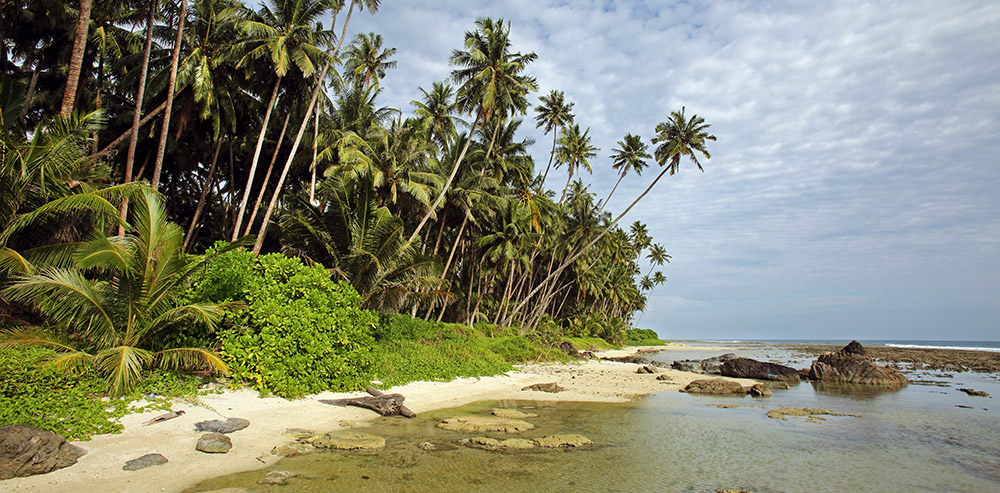
Sema-Sema beach can be reached on foot by walking west along the coastline from Sorake Beach.
Baloho Beach
Between Lagundri bay and Teluk Dalam (east of Sorake) there are three bays. The one closest to Teluk Dalam is called Baloho. This bay is very scenic and easily accessible (yet a bit tricky to find) from the main road. Next to the main beach there is a resort with a nice bar area where you can eat and have a few drinks overlooking the bay. Along the beach there are also a few local cafes which unfortunately generate a lot of litter. The most beautiful parts of the beach is actually further out in the bay, either 500 meters west of the resort or one kilometer south, close the entrance of the bay. It’s also possible to drive by motorbike to this area which is called Pantai Nifu’ele.
Walohiu and Sobagimböhö Beach
A beautiful beach which is also its own island, cut off from the mainland by a river. To get there from Sorake drive up the hill to Botohili village. Continue behind the village northwest for c. four kilometers on the small road on top of a ridge towards Hilisalo’o village. There is a road being built from the village all the way down to the beach. If its not ready, park in the village and walk down. You can get locals in the village to show the way. When you get down to the water it is usually no problem to wade or swim across the river to the island. After rains there may be a strong current locals may offer (at a charge) to take you across in a small boat. The island is only a couple of hundred meters wide but 5 kilometers long. The beach facing the oceans runs all the way to the northern end of the island. The northern end of the beach is called Sobagimböhö Beach. Surfers sometimes come here for the waves at both ends of the beach or the beach break right in front of the beach.
Moale Beach
Pantai Moale is a four kilometer long completely natural beach on the north-west coast of South Nias. According to locals this is the most beautiful beach in the region, and many visitors agree. Its an amazing place to watch and photograph sunsets. Due to the beauty of this location an international hotel company planned to build a huge resort here in the 90’s. What they didn’t think of was that during the swell season the waves pound the beach with the full force of the Indian Ocean and swimming is not safe. Despite this it is a beautiful beach and it is possible to swim during calmer conditions. Moale Beach is 35 kilometers drive from Sorake near Lölöwa’u village in Amandraya sub-district.
Nature
Just like elsewhere on the island there are many amazing natural attractions hidden in the hilly green interior of South Nias. However most of them are very difficult to get to. Here is a list of some of the more accessible places:
Waterfalls and swimming holes
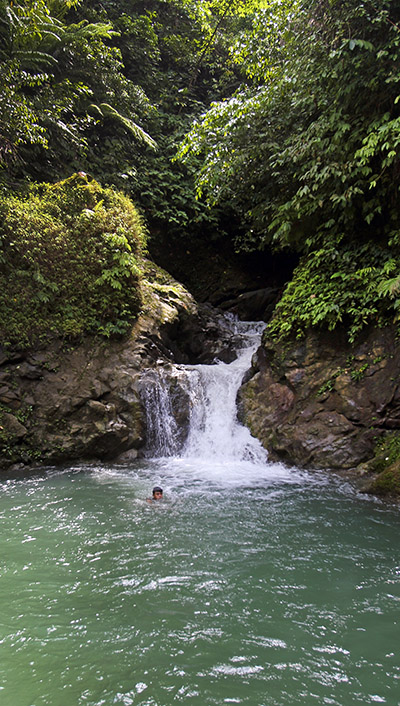
Somali waterfall
All the accessible waterfalls are also near other points of interest and are usually visited in conjunction with a trip to a traditional village. It’s a great way to cool off on a hot day. Be warned that all of these places include walking on narrow, steep and slippery tracks.
Namo Si Felendrua – amazing section of rapids, swimming holes and small waterfalls in a steep ravine not far from Bawömataluo village. Go with a guide and be prepared for some serious down/uphill walking.
Somali waterfall – small waterfall and beautiful natural swimming pool just below Onohondrö traditional village.
Pantai Ladeha – the main attraction here is not the beach itself but some spectacular rock formations along the coast including some beautiful green rock pools. Ladeha beach is ca. 30 kilometers drive north of Sorake near Lolomoy village in Amandraya sub-district.
Gomo Area – There are several traditional villages and megalithic sites in the Gomo area. Visitors to Gomo usually also include a trip to Helewomo waterfall and a few others in the Börönadu sub-district. Gomo is quite far from Sorake, and it takes at least three hours to get there by motorbike or four-wheel drive. On the way up to Gomo it is possible to visit a few more waterfalls.
Mountains and viewpoints
Lölömatua (885 m) is the highest mountain on Nias Island and offers great views of the surrounding landscape. Young and patriotic Niasans often climb this mountain at dawn on the 17th of August (National Day of Indonesia) to raise the flag at sunrise. The climb is not difficult but it’s a 2-3 hours drive from either Sorake or Gunungsitoli to the start of the walk.
Genasi viewpoint – Most people going to Sorake or Teluk Dalam will pass this hill on the way south. Genasi has great view of the southern coastline. There is a café here and it is a good place to take a break.
Cultural Heritage Sites
Before surfers ‘discovered’ Nias, the unique cultural heritage of the island was well known in anthropological circles and subject to many in-depths studies by visiting academics. Even today researchers from all over the world regularly visit Nias heritage sites, particularly in the south. Several books have been written about the history, culture and architecture of this amazing region. Needless to say a visit to one of the traditional villages is a must if you come to Nias. More in-depth description of Nias cultural heritage is outlined on the Culture page on this website. Here is a short overview of the most interesting and accessible traditional villages in the south. Many of the villages are in clusters so it is possible to conveniently visit more than one during an outing. The Nias Heritage Museum has more information about interesting cultural heritage sites in South Nias.
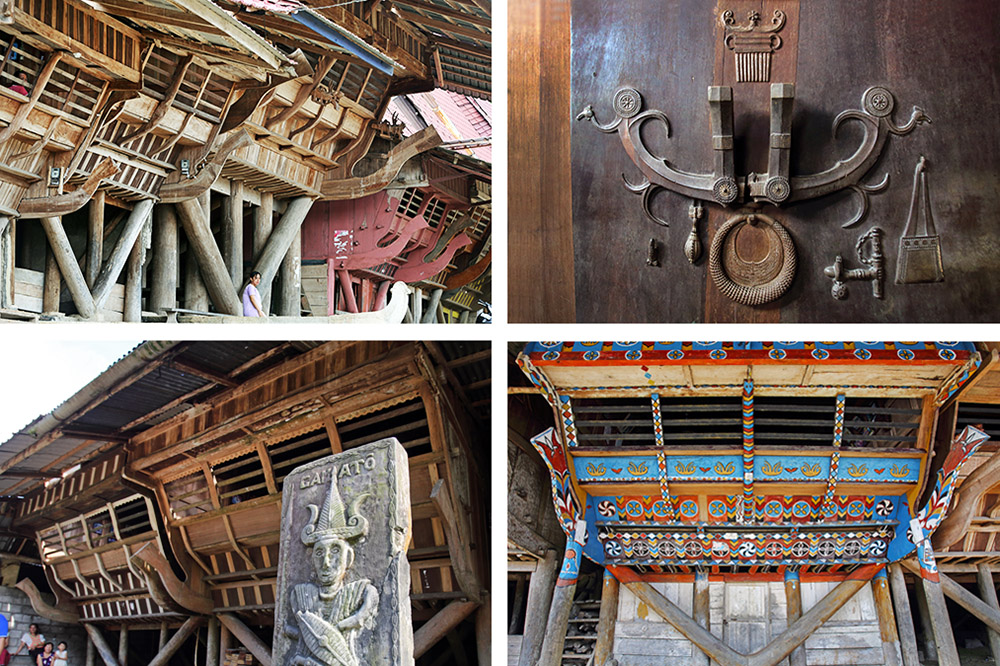
South Nias traditional villages; amazing examples of indigenous architecture and highly skilled craftsmanship.
Around Sorake
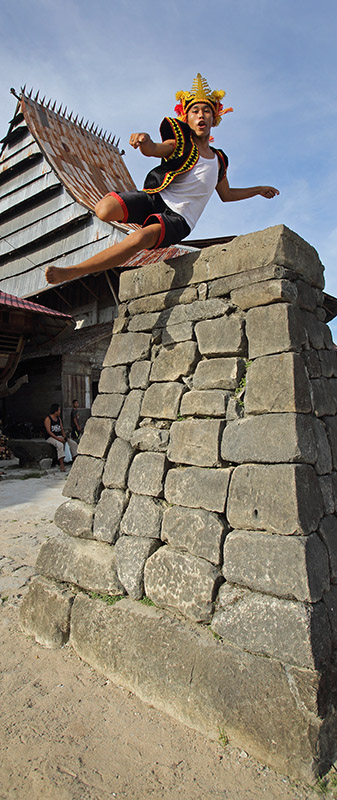
Bawömataluo stonejumper.
Bawömataluo is the largest and one of the best preserved traditional villages in the south. It is sometimes referred to as the Kings Village. Rather than a king, there was a powerful tribal chieftain who used rule the immediate area from here. This village regularly recieves visitors and the local boys perform the famous stone jumping ceremony for a fee. Bawömataluo is less than 30 minutes’ drive from Sorake or Teluk Dalam.
Just a few hundred meters down the hill is Orahili village which is also well worth a visit. A couple of kilometers past Bawömataluo at the end of a narrow road lies Lahusa Fau village. While not as large as the other two it is also interesting.
Botohili is the most visited traditional village in Nias, for the simple reason that it is walking distance from Sorake. Botohili has a mix of modern, old and ‘hybrid’ houses and is just a ten minute walk up the hill from Sorake.
Hiliamaetaniha is a very accessible village only ten minutes from Sorake. This village is located on top of a hill with spectacular views. It is special because almost all the houses in the village are still traditional, which makes this one of the highlights of the living culture of South Nias.
For the following villages it is strongly recommended to go with a local guide as the exact location can be hard to find and locals there are not as used to receiving outside visitors.
North of Sorake
On a day trip north of Sorake it is possible to visit four very interesting villages, each one unique in its own way. The first village, ca 10 kilometers north of Sorake is Hilisimaetanö, which is one of the largest traditional settlements in the south. Further north along the main road is a small turn off (motorbike or four-wheel drive only) which leads to the three villages Bawogosali, Hilinawalö Fau and Onohondrö. Go with a local to find the way.
From Teluk Dalam
From the town there is a narrow road north (uphill) which leads to the very interesting and well preserved village of Hilimondregeraya. Not far from this village at the end of a narrow broken track is Hilinamö Zaoa village.
North-east of Teluk Dalam
From Teluk Dalam drive north along the east-coast road. Just after Genasi viewpoint is the turn off to Hilinawalö Mazinö village which has one of the largest traditional Clan houses (Omo Sebua) on Nias. To reach the village follow the rough road for six kilometers until the end of the road.
Gomo & Lahusa Area
According to legend the Gomo area is the birthplace of Nias people. This is where the first ancestors came down from heaven to live on earth. Even today it is considered the spiritual and cultural heartland of Nias. Until recently you could only reach this area by foot. Travel to Gomo/Lahusa still takes a few hours and roads can be rough. There are a number of unique traditional villages and megalithic sites in the Gomo region. A trip to Gomo is a full day trip, and many people actually end up staying overnight in order to take everything in. Gomo is about 2.5 hours or more from Sorake and 3 hours from Gunungsitoli. Note that there are only two very basic guesthouses in this region, both of them in Orahili Gomo village. Because Gomo only recently opened up to visitors it is recommended that you travel with a local guide, even if you speak Indonesian.
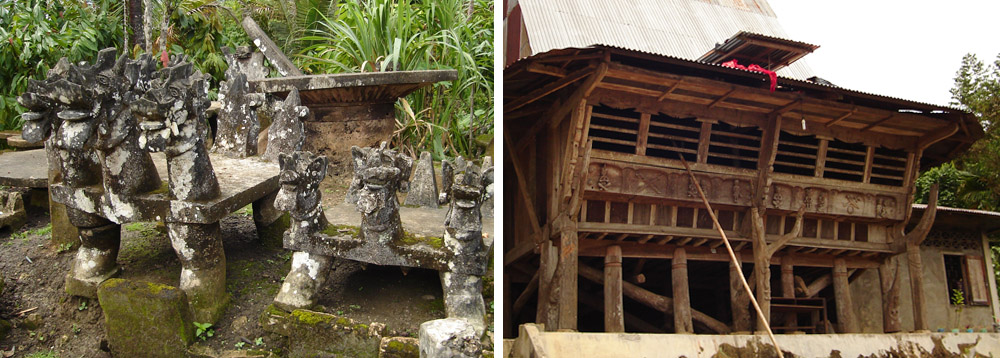
Megaliths and traditional houses in the Gomo region. Photo courtesy of Agus Mendröfa.
Some of the highlights of Gomo region are:
Tetegewo megalithic site in Hlisao’ötö Village, Sidua’öri sub-district. This abandoned village site sits on top of a steep hill. The hill is filled with almost 100 different megaliths of different types. Perhaps the most impressive megalithic site in all of Nias.
Tundrumbaho megalithic site in Ulu Idanoetae sub-district. Smaller and more overgrown than Tetegewo it is still very interesting due to some very large osa-osa statues.
Lahusa Satua village in Ulu Idanoetae sub-districts is perhaps the most interesting village in the area due to its combination of many unique megaliths and a traditional house with many carvings. There are some ‘skull coffins’ which still contains human skulls (not from head hunting, but from ancestors).
Sifaoro’asi Gomo village in Gomo sub-district have two easily accessible spectacular traditional houses with many sculptures and wood carvings.
Sifalagö Susua village in Ulu Susua sub-district. This village past Gomo have several interesting traditional houses including a large Chiefs house and many megaliths. Although interesting, this village is seldom visited due to the difficult access.
Simandraolo village in Ulu Idanotae sub-district have a large traditional houses and many megaliths and sculptures. These megaliths are more modern and therefore more detailed.
Gui-Gui village in Mazö sub-district is not far from Sifaoro’asi Gomo village. There is a traditional house with very unique decoration.
Orahili Sibohou village in Gomo sub-district; some megaliths including a coffin and a very large traditional house.
Sifalago Gomo village in Börönadu sub-district is considered the ‘first’ village in the region and it has a grave marker for the Hia clan. There are some simple megaliths in the village and a traditional house. Access is difficult. Not far from this village you can visit spectacular Helaowo Waterfall, only 5 minutes walk from the road.
Hililaora village in Sidua’öri sub-district has a traditional house which is very accessible next to the road on the drive to central Gomo.
Mondrowe waterfall is a good place to stop for photos and a cooling dip on the way up or down from Gomo.
Many visitors compare Gomo to northern Laos and Thailand because of the step hills covered in jungle. So far there is no organised trekking activities here, but if it takes off on Nias, Gomo will be the trekking capital of the island. Some adventurous travelers have already done overnight treks with local guides from Börönadu to Lölömatua sub-district and from Gomo all the way to Idanogawo in Nias District.
Local guides
Some of the sights near Sorake are easy to find and people there are used to outside visitors. But some places further afield are hard to find by yourself, especially if you don’t speak Indonesian. For more remote locations we recommend that you visit with a local. Any overnight walk should always be accompanied by a local. You can ask for help at your guesthouse, often someone there can go with you, or they can recommend someone who will. Mr Gaya Gee in Lagundri village is very helpful and knows this area well. Find him at Rumah Makan Anisa or contact him via Mob: +62 81361036440 E: geegayabaru@gmail.com
Things to do on Telo Island
Surfing is still the main attraction here, but there are lot of other things to do as well. If you stay in one of the resorts you will be very well taken care of. Apart from having your very own surf guide there are plenty of other things to keep you busy here; snorkelling, fishing, kayaking, birdwatching, exploring rivers and visiting local villages to mention a few. If you stay in a local guesthouse you have to make things happen by yourself. Either you stay where you are and enjoy some relaxing island time including beach chill and snorkelling, or you hire a local boat to explore further.

Telo Islands from above. Photo by Telloku.
Telos is largely unexplored by tourists and to keep some of the magic for future visitors we will not list exact locations of surf spots and beaches.


